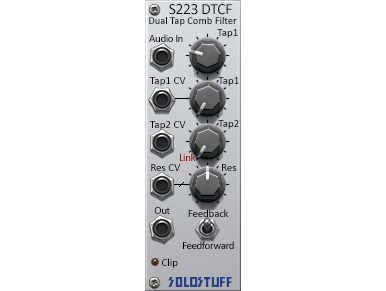Product Description
(This module is included in the System B)
A comb filter adds a slightly delayed version of the input audio to itself causing both constructive and destructive effects in the frequency spectrum. The response has a haircomb like look to it in the spectrum. Hence the name. Comb filters have several applications in DSP, for example, constructing flangers or reverb effects.
A tap represents the delay time. A single tap comb filter has one short delay line. The S223 has two taps but still using a single delay line!!. Thats like one bird with four wings. Tap1 is the master tap which has a harder impact on the sound. While Tap2 always moves around Tap1 and has a more subtle effect when Tap1 is not low.
When Tap2 knob/CV is put at minimum, it becomes in link mode. Which makes Tap2 always follow Tap1. Which makes the filter behave as a SINGLE tap comb. This will give a much stronger and typical effect of a usual comb filter.The filter also has resonance Knob/CV control. CV of resonance can go to negative values which would flip the spectrum (i.e peaks become valleys and valleys become peaks).
There are two topologies that can be switched. Feedback and Feedforward. Feedback is useful for creating several type of effects like flangers, reverbs, etc (Try mixing several modules). Feedforward is more subtle and can be used to create pulse width modulation type of effects. For further technical details regarding the two topologies, have a look here: https://www.dsprelated.com/freebooks/pasp/Comb_Filters.html


Reviews
There are no reviews yet.